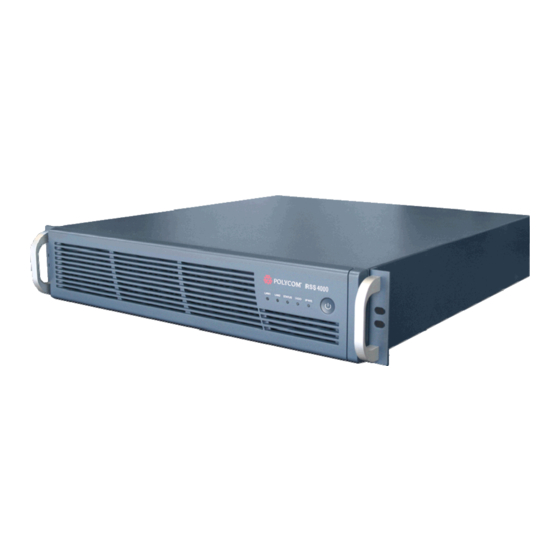
Polycom RSS 4000 Getting Started Manual
System
Hide thumbs
Also See for RSS 4000:
- User manual (146 pages) ,
- Getting started manual (14 pages) ,
- User manual (106 pages)
Table of Contents
Advertisement
Quick Links
Download this manual
See also:
User Manual
Advertisement
Table of Contents

Summary of Contents for Polycom RSS 4000
- Page 1 ® ™ Polycom 4000 System Getting Started Guide 7.0.0 Oct. 2011 3725-32871-002/C...
- Page 2 As between the parties, Polycom, Inc., retains title to and ownership of all proprietary rights with respect to the software contained within its products. The software is protected by United States copyright laws and international treaty provision.
-
Page 3: Table Of Contents
Ready for Use ············································································ 10 Maximum Capacity ····································································· 11 TCP/UDP Port Usage ···································································· 12 Notes Regarding On Demand Archive and Live streaming ···················· 13 Configuring Windows Media Player to receive streaming media ·············· 13 Hardware Specification ································································ 14 Polycom Solution Support Services ·················································· 14... -
Page 4: General Safety Precautions
Take all items out of the package and check if any of them is in poor condition. If you find damage, file a claim with the delivery carrier. Polycom is not responsible for damage sustained during shipment of this product. -
Page 5: System Indicators
Polycom® RSS™ 4000 Getting Started Guide – Version 7.0 To install system hardware Place the Polycom® RSS™ 4000 unit on a stable flat surface in the selected location. Insert each power cord connector into the rear of the unit and connect each to an appropriately rated socket outlet. -
Page 6: Preparations Before Configuration
Preparations before Configuration Obtaining the Network Information Before the initial configuration, get the following information from your network administrator to configure Polycom® RSS™ 4000 to your local network: • IP address, subnet mask, and default gateway IP address to be assigned to Polycom®... -
Page 7: Obtaining The Product Activation Key
Before using Polycom® RSS™ 4000, you need to obtain the product activation key. When you power on and log in to the Polycom® RSS™ 4000 for the first time, the system displays the product activation page, prompting you to enter a product activation key. - Page 8 Polycom® RSS™ 4000 Getting Started Guide – Version 7.0 address bar, and then press Enter. By default, Polycom® RSS™ 4000 Web server has an untrusted certificate and uses the HTTPS protocol to set up SSL secure connection with client end.
- Page 9 Polycom® RSS™ 4000 Getting Started Guide – Version 7.0 Parameter Description Enable IPv6 Specifies whether to enable IPv6 related functions. Obtain an IP Address Specifies whether to obtain the IPv6 address automatically using Automatically (IPv6) Stateless Address Auto-configuration (SLAAC). Using the following IP Selects this option to manually configure a static IPv6 address.
- Page 10 10 Click Update and confirm to restart the system to apply the setting. To change IP address via RS-232 Console or Telnet: Connect your PC to the RS232 port of the Polycom® RSS™ 4000 with a serial port cable and activate the console port (115200,8bits).
-
Page 11: Installing Multicast Controls (Optional)
When you activate the device and subsequently connect to the system's web management interface for the first time, you will be prompted that a Polycom RSS 4000 multicast add-in is required at the top of the browser. Make sure you use the Internet Explorer browser. -
Page 12: Sip Configuration (Optional)
SIP Configuration (Optional) If your network supports the Session Initiation Protocol (SIP), you can use SIP to connect IP calls. The Polycom® RSS™ 4000 system supports only the integration with Polycom DMA SIP server. To configure the SIP settings: Click System Config >... -
Page 13: Ready For Use
Polycom® RSS™ 4000 Getting Started Guide – Version 7.0 Parameter Description Specifies the IP address, connection port, and domain name of SIP Server the SIP server for registration service. Register User Information Specifies the user name and password that authenticates the system to the SIP Server. -
Page 14: Maximum Capacity
Polycom® RSS™ 4000 Getting Started Guide – Version 7.0 Maximum Capacity Device maximum capacity Feature Description Small Medium Large How many devices can connect to a Polycom® RSS™ 4000 simultaneously? Signaling Connection Note: Include connection types: recording with live streaming, recording only and playback. -
Page 15: Tcp/Udp Port Usage
Polycom® RSS™ 4000 Getting Started Guide – Version 7.0 The resources used for playback, conference recording, and live streaming increase progressively; and they are exclusive. For example, on a Small Model device, if there are already four single-point conferences being live streamed (also being recorded.), and then the fifth live streaming will be rejected, but one more recording and ten sessions of playback are allowed. -
Page 16: Notes Regarding On Demand Archive And Live Streaming
Open an outbound UDP port range matching what is used by Windows Media Player, or open all UDP ports outbound from Polycom® RSS™ 4000 to effectively bypass the firewall for outbound traffic. Also open the port range used by Windows Media Player for inbound traffic to the viewing PC. -
Page 17: Hardware Specification
Additional services for supported third-party Unified Communications (UC) environments integrated with Polycom solutions are available from Polycom Global Services and its certified Partners. These additional services will help customers successfully design, deploy, optimize and manage Polycom visual communications within their UC environments. Professional Services for Microsoft Integration is required for Polycom Conferencing for Microsoft Outlook and Microsoft Office Communications Server integrations.







Need help?
Do you have a question about the RSS 4000 and is the answer not in the manual?
Questions and answers